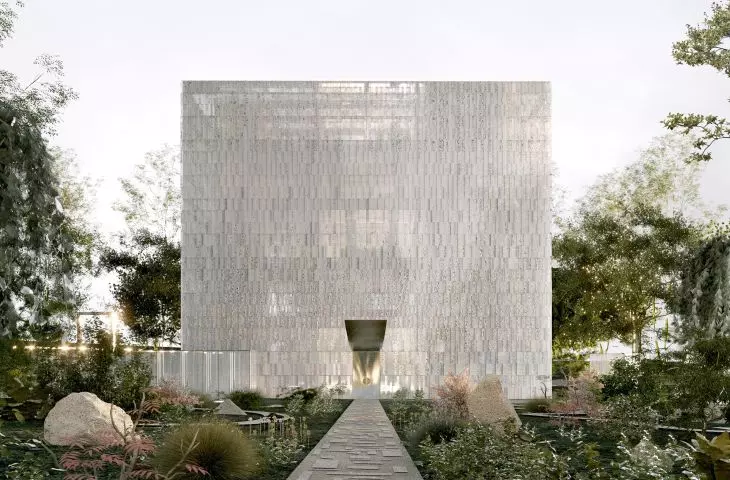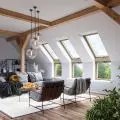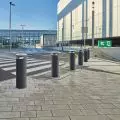The {tag:studenci}, a graduate of the Faculty of Architecture at Poznan University of Technology, has proposed a solution that could become the future of manufacuturing and provide an answer to the problems of global manufacturing. The two facilities she designed combine research methods, functional, material and technological solutions, enabling specialists to co-create innovative biomaterials, and apply them to the design arts. The author suggested the French town of Cergy and Paris as exemplary locations for Plastic Platforms.
The author chose Paris as one of the facility's locations
© Anna Bukowy
The master's thesis Plastic Platforms, carried out under the supervision of Dr. Agata Gawlak, Prof. PP, represents a continuity of projects according to the new sustainable future of the manufactory. As a complement to the theme, the work is an attempt to spatially reflect holistic thinking about new production structures. The theme is an analysis and response to the issues of social, historical, economic aspects touching architecture and industrial design. The author extensively explores the cultural dependencies of the French context as an exemplary location for the new model, thus responding to historical continuity and building an unconventional pattern.
Plastic Platforms, collages
© Anna Bukowy
new typology
The Plastic Platforms project is a new typology of the manufactory to address the problems of global production—increasing waste, the disappearance of craftsmanship and production exclusion. The model, according to the author, is intended as a medium in which the research and creative interaction of specialists—scientists, artists, craftsmen, designers and amateurs—focuses on the co-creation of innovative biomaterials, and their application in the design arts.
axonometries of buildings in Cergy and Paris
© Anna Bukowy
Global issues have created new opportunities for designers. Today we are at the end of the depletion of natural resources. Building awareness by rejecting the boundary between manmade and manufaktura offers the possibility of noticeable changes in creating the image of design and reducing consumerism. The continuation of the traditional and local pattern of the manufactory is contained in the programmatic dichotomy of my proposed facilities that constitute a center for research, production, exhibition and education," explains the architect.
Two locations of a single premise combine research methods, functional, material and technological solutions. The association of individually active people through the proliferation and dispersal of buildings is intended to contribute to a network of platforms for the collective development of local productions.
interiors in Cergy and Paris
© Anna Bukowy
past and future
The new form of manufactory proposed by the architect is the idea of a space that combines the experiences of the past and visions of the future in terms of biomaterials, recycled materials and attempts to create a new design canon. Anna Bukowy hopes that her project will take on the critical function of the existing production system, but also give a new start to thinking about aesthetics, meeting the needs of society, and coexisting in harmony with the environment.
Material in the raw is nothing much. Only worked material has quality, and pieces of worked material are made to show their quality by men, or put together they show a quality which singly they had not. "Good Material" is a myth—David Pye 1 .
cross-section of buildings in Cergy and functional diagram
© Anna Bukowy
new global network
Plastic Platforms is creating a field of global influence, becoming a model for new activities of local manufactory, a space for social relations combining ambition and the will to change. The project expresses a vision of a sustainable, conscious future, built through a network of relationships, knowledge and experience. The empirical way of learning about the production process aims to redefine the daily life of each individual making up society as a whole, says Anna Bukowy.
The platform is not only a way of rising buildings or people from the ground, but also an architectural form that redefines and negotiates the way in which the ground itself is made inhabitable. While often seen as a symbol of power, the platform has also served as a gathering place: a point of orientation and exchange among communities—Pier Vittorio Aureli, Martino Tattara 2.
detail and idea of the platform
© Anna Bukowy
biomaterials and recycled materials
In keeping with the idea of local design, consistent with the main ideas of the entire Plastic Platforms business, it was crucial for the author to use local materials. One of these is a variety of lutecky limestone characteristic of the Paris area and its region.
In the 20th century, quarries were established in the Ile-de France region about forty kilometers from Paris, which are characterized by the quarrying of thinner layers of limestone used for exclusive projects. The variety is called stone from the Oise River, which borders my proposed Plastic Platforms location in Cergy, the designer adds.
Another material used by the architect is wood, which, used in the ceilings, is combined with a stone column structure.
The interiors of the laboratory and studio in Cergy
© Anna Bukowy
The premise of the project is to maximize the use of biomaterials, recycled materials and artisanal forms to build the image of the building through the facade, structure and finishes.
The facade is covered with a biomaterial created from clam shells that is an alternative to glass
© Anna Bukowy
The recycled material used in the construction of the platform is Precious Plastic. It can be found in some of the building structures, but also interior finishes in the form of products from LePave, a Paris-based company. Meanwhile, one of the alternatives of glass used for façade coverings has become a biomaterial created from mussel shells, created by artist Lulu Harrison and developed in the form of façade tiles by London-based company Bureau de Change. Anna Bukowy also used textured glass bricks made by Olivier Juteau.
1. D. Pye, "The Nature and art of workmanship," London 2015
2




















































































